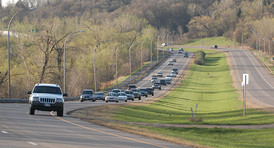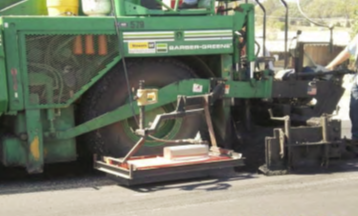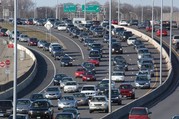Transportation Research Update


Recent MnDOT research shows new technology can be paired with existing equipment to count and classify the traffic on Minnesota’s roadways. Different classes of vehicles—from motorcycles to cars to all sizes of trucks—impact roadways and traffic differently. MnDOT needs to know the number and classes of vehicles that are using the roads it manages. This data is used for planning, funding, maintenance and other decision-making.
Historically, MnDOT has used a variety of equipment and methods to classify vehicle traffic. Most of these methods are either expensive, time-consuming or simply not sufficient for the agency’s data needs. Inductive loop signature technology can be installed at existing automatic traffic recording sites to produce electronic signatures, or footprints, for each passing vehicle. Previous research on this technology resulted in the need for more data and technology refinement. Through technology updates and improvements to system data, MnDOT is now confident this is a feasible and cost-effective tool to gather the vehicle classification data it needs.
Report #2021-27
|

Compaction is the final and most critical step in asphalt pavement construction. Heavy rolling equipment is used to squeeze just the right amount of air out of the pavement before it hardens or gets too stiff. But it’s no easy task. While squeezing the mixture together results in higher stability and pavement strength, too little or too much compaction or consolidation of the pavement can lead to costly premature maintenance and repair expenses.
A national study conducted several years ago indicated that a slightly more compact pavement than typical could help roads last longer. Now, researchers have built a new database for MnDOT to test that theory. By entering and analyzing density data pulled from samples collected from newly constructed roads around the state, then seeing how those roads have held up over time, MnDOT hopes to eventually have enough data to definitively determine how much compaction is the right amount to ensure pavements last longer.
Report #2021-28
|

In 2019, MnDOT produced a comprehensive and accessible culvert design guide to help Minnesota practitioners design culverts that support stream connectivity and the passage of aquatic organisms. In this study, researchers sought to ensure that culverts designed using the guidance would continue to work well in future high- and low-flow events brought on by climate change. The research team assessed 50 culverts across the state to identify current connectivity challenges and then used modeling software and historic data to simulate possible drought and flood scenarios. The results showed that culverts built according to the design guidance will likely continue to allow fish and other aquatic wildlife to pass through despite changing environmental conditions.
Report #2021-29
|

Providing consistent freeway travel times for Twin Cities area drivers requires careful traffic management and well-planned freeway projects. To effectively respond to incidents and identify the most needed renovations, MnDOT traffic managers need to know precisely where, when and why congestion is happening. New research provides a software tool to understand congestion and its causes on freeway corridors in the metro area.
Expanding on previous work, investigators developed comprehensive enhancements for a tool that estimates travel-time reliability—how consistent or dependable travel times are on a specific stretch of highway during a given time of day. With the construction of an extensive database of historical travel conditions and driving times, they calculated several new measures to understand travel-time reliability and the factors that impact freeway congestion, such as weather, work zones and highway geometry. They analyzed conditions on 48 freeway routes and started exploring a measure of the operational resilience of a highway corridor, which refers to the capability of the corridor to adapt and recover from disturbances that lead to congestion.
Report #2022-01
|
 MnDOT’s existing and future assets will become increasingly stressed by extreme weather patterns due to climate change. Minnesota’s assets are particularly vulnerable to projected precipitation increases and larger and more frequent extreme storm events.
The agency is currently developing a process for evaluating future flood risk to MnDOT bridges, large culverts, and pipes. Studying the performance of infrastructure under predicted extreme events will help MnDOT assess the impacts of climate change to plan, design, build, and maintain assets for resilience.
MnDOT hosted a webinar on the Extreme Flood Vulnerability Analysis project on March 22, 2022.
Visit MnDOT Climate Resilience to learn more.
-
Minnesota Drivers may Hit 20 Times the Deer Reported to State (4/1/22, Duluth News Tribune)
-
University of Minnesota Launches New App to Connect Farmers (3/23/22, FOX 9)
-
During Surge of Speeding Drivers, Pedestrian Fatalities were Highest in MN in 5 Years: Studying What Makes Pedestrians Safer (2/17/22, Pioneer Press)
|